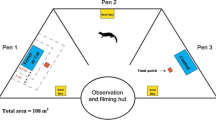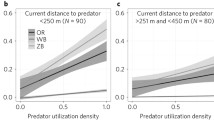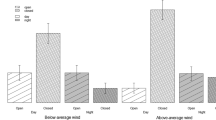Abstract
Many prey animals experience temporal variation in the risk of predation and therefore face the problem of allocating their time between antipredator efforts and other activities like feeding and breeding. We investigated time allocation of prey animals that balanced predation risk and feeding opportunities. The predation risk allocation hypothesis predicts that animals should forage more in low- than in high-risk situations and that this difference should increase with an increasing attack ratio (i.e. difference between low- and high-risk situations) and proportion of time spent at high risk. To test these predictions we conducted a field test using bank voles (Clethrionomys glareolus) as a prey and the least weasel (Mustela nivalis nivalis) as a predator. The temporal pattern and intensity of predation risk were manipulated in large outdoor enclosures and the foraging effort and patch use of voles were measured by recording giving-up densities. We did not observe any variation in feeding effort due to changes in the level of risk or the proportion of time spent under high-risk conditions. The only significant effect was found when the attack ratio was altered: the foraging effort of voles was higher in the treatment with a low attack ratio than in the treatment with a high attack ratio. Thus the results did not support the predation risk allocation hypothesis and we question the applicability of the hypothesis to our study system. We argue that the deviation between the observed pattern of feeding behaviour of bank voles and that predicted by the predation risk allocation hypothesis was mostly due to the inability of voles to accurately assess the changes in the level of risk. However, we also emphasise the difficulties of testing hypotheses under outdoor conditions and with mammals capable of flexible behavioural patterns.



Similar content being viewed by others
References
Bolbroe T, Jeppsen LL, Leirs H (2000) Behavioural response of field voles under mustelid predation risk: more than neophopia. Ann Zool Fenn 37:169–178
Brown JS (1988) Patch use as an indicator of habitat preference, predation risk and competition. Behav Ecol Sociobiol 22:37–47
Brown JS, Morgan RA, Dow BD (1992) Patch use under predation risk. II. A test with fox squirrels, Sciurus niger. Ann Zool Fenn 29:311–318
Bujalska G (1973) The role of spacing behaviour among females in the regulation of the reproduction in bank voles. J Reprod Fertil [Suppl] 19:465–474
Fryxell JM, Lundberg P (1998) Individual behaviour and community dynamics. Chapman and Hall, London
Gipps JHW (1985) Spacing behaviour and male reproductive ecology in voles of the genus Clethrionomys. Ann Zool Fenn 22:343–351
Hamilton IM, Heithaus MR (2001) The effects of temporal variation in predation risk on anti-predator behaviour: empirical test using marine snails. Proc R Soc Lond B 268:2585–2588
Hik DS (1995) Does risk of predation influence population dynamics? Evidence from the cyclic decline of snowshoe hares. Wildl Res 22:115–129
Jędrzejewska B, Jędrzejewski W (1990) Antipredatory behaviour of bank voles and prey choice of weasels—enclosure experiment. Ann Zool Fenn 27:321–328
Jędrzejewski W, Jędrzejewska B (1990) Effect of a predator’s visit on the spatial distribution of bank voles: experiments with weasels. Can J Zool 68:660–666
Jędrzejewski W, Rychlik L, Jędrzejewska B (1993) Responses of bank voles to odours of seven species of predators: experimental data and their relevance to natural predator vole relationships. Oikos 68:251–257
Jędrzejewski W, Jędrzejewska B, Zub K, Nowakowski WK (2000) Activity patterns of radio-tracked weasels Mustela nivalis in Bialowieza National Park (E Poland). Ann Zool Fenn 37:161–168
Kats LB, Dill LM (1998) The scent of death: chemosensory assessment of predation risk by animals. Ecoscience 65: 689–701
Koivisto E, Pusenius J (2003) Effects of temporal variation in the risk of predation by least weasel (Mustela nivalis) on feeding behaviour of field vole (Microtus agrestis). Evol Ecol 17:477–489
Kokko H, Ruxton GD (2000) Breeding suppression and predator-prey dynamics. Ecology 81:252–260
Korpimäki E, Norrdahl K, Rinta-Jaskari T (1991) Responses of stoats and least weasels to fluctuating food abundance: is the low phase of the vole cycle due to mustelid predation? Oecologia 88:552–561
Korpimäki E, Koivunen V, Hakkarainen H (1996) Microhabitat use and behaviour of voles under weasel and raptor predation risk: predator facilitation? Behav Ecol 7:30–34
Kotler BP, Ayal Y, Subach A (1994) Effects of predatory risk and resource renewal on the timing of foraging activity in a gerbil community. Oecologia 100:391–396
Lima SL (1998) Stress and decision-making under the risk of predation: recent developments from behavioral, reproductive and ecological perspectives. Adv Study Behav 27:215–290
Lima SL, Bednekoff PA (1999) Temporal variation in danger drives antipredator behavior: the predation risk allocation hypothesis. Am Nat 153:649–659
Lima SL, Dill LM (1990) Behavioral decisions made under the risk of predation: a review and prospectus. Can J Zool 68:619–640
McPhee EM (2003) Generations in captivity increases behavioral variance: considerations for captive breeding and reintroduction programs. Biol Conserv 115:71–77
Norrdahl K, Korpimäki E (1995) Mortality factors in a cyclic vole population. Proc R Soc Lond B 261:49–53
Norrdahl K, Korpimäki E (2000) The impact of predation risk from small mustelids on prey populations. Mammal Rev 30:147–156
Nyholm ES (1959) Stoats and weasels in their winter habitats (in Finnish). Suomen Riista 13:106–116
Pecor KW, Hazlett BA (2003) Frequency of encounter with risk and the tradeoff between pursuit and antipredator behaviors in crayfish: a test of the risk allocation hypothesis. Ethology 109:976–106
Pusenius J, Ostfeld RS (2000) Effects of stoat’s presence and auditory cues indicating its presence on tree seedling predation by meadow voles. Oikos 91:123–130
Ronkainen H, Ylönen H (1994) Behaviour of cylic bank voles under risk of mustelid predation: do females avoid copulation? Oecologia 97:377–381
Ruxton GD, Lima SL (1997) Predator-induced breeding suppression and its consequences for predator-prey population dynamics. Proc R Soc Lond B 264:409–415
Sih A, McCarthy TM (2002) Prey responses to pulses of risk and safety: testing the risk allocation hypothesis. Anim Behav 63:437–443
Sinclair ARE, Arcese P (1995) Population consequences of predation-sensitive foraging: the Serengeti wildebeest. Ecology 76:882–891
Sundell J, Norrdahl K, Korpimäki E, Hanski I (2000) Functional response of the least weasel (Mustela nivalis nivalis). Oikos 90:501–508
Sundell J, Eccard J, Tiilikainen R, Ylönen H (2003) Predation rate, prey preference and predator switching: experiments on voles and weasels. Oikos 101:615–623
Van Buskirk J, Muller C, Portmann A, Surbeck M (2002) A test of the risk allocation hypothesis: tadpole responses to temporal change in predation risk. Behav Ecol 13:526–530
White MD (1998) Horizontal distribution of pelagic zooplankton in relation to predation gradients. Ecography 21:44–62
Ylönen H (1989) Weasels Mustela nivalis suppress reproduction in cyclic bank voles Clethrionomys glareolus. Oikos 55:138–140
Ylönen H (2001) Predator odours and behavioural responses of small rodents: an evolutionary perspective. In: Peltz H-J, Cowan DP, Feare CJ (eds) Advances in vertebrate pest management 2. Filander, Fuerth, pp 123–138
Acknowledgements
We are grateful to Marko Haapakoski and Elina Rantanen for their assistance in conducting the experiment. We thank Res Altwegg and two anonymous referees for comments on the manuscript. The study was funded by the Academy of Finland (project no. 44878; Finnish Centre of Excellence Programme 2000–2005).
Author information
Authors and Affiliations
Corresponding author
Rights and permissions
About this article
Cite this article
Sundell, J., Dudek, D., Klemme, I. et al. Variation in predation risk and vole feeding behaviour: a field test of the risk allocation hypothesis. Oecologia 139, 157–162 (2004). https://doi.org/10.1007/s00442-004-1490-x
Received:
Accepted:
Published:
Issue Date:
DOI: https://doi.org/10.1007/s00442-004-1490-x




